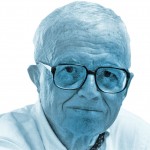
A few weeks ago (“The Right to Write”) I urged readers of this column not to shy away from writing about their life and their family history. Many families have unexpected stories waiting to be found and told and pondered. Here’s one that took me by surprise.
In the 1970s, when our son, John Zinsser, was starting his career as a painter, his dealer gave him several one-man shows in small storefronts in Soho. One was so minimal that the building had no sign announcing that it was an art gallery or that an exhibition was on view.
One Saturday afternoon in 1979 an older woman from Germany, in New York to visit her married daughter, was walking along that block when her eye was caught by John’s paintings through the gallery window. She went inside, liked the paintings, and bought one to take home to Germany the next day. As she was leaving, she said, “Who is the artist?” Told that it was John Zinsser, she said, “That was my mother’s maiden name.”
When I heard that story, I tracked down the daughter, Annette Cantor, by phone at her Greenwich Village apartment and asked, “Who are you guys?” She said that the family was from Cologne and that her mother, Libet Werhan, was an artist. But how were we related? What genetic pull had John’s paintings exerted through the gallery window on the woman from Germany? Annette and I uncovered the trail.
My great-grandfather, William Zinsser, emigrated from Germany in 1849 and founded a shellac business that would stay on the same block in mid-Manhattan for 125 years. Two brothers came with him. One, August, was a banker whose descendants, some of whom settled in Hastings-on-Hudson, N.Y., included the bacteriologist Hans Zinsser, widely known for his best-selling books Rats, Lice and History and As I Remember Him. The other brother, Frederick, a doctor, eventually returned to Germany, where his son Ferdinand, also a doctor, had a daughter, Augusta. She married a promising young lawyer in Cologne named Konrad Adenauer, and it was their daughter, Libet, who bought John’s painting. She was a cousin only slightly removed.
Two decades later, in 2003, John Zinsser, now an established artist, flew to Cologne for the opening of his one-man show at a major gallery. He had sent an invitation to his cousin Libet, a grande dame of the Cologne art scene, and she made a grand entrance, handing out her card, which, in the lower left corner, said geb. Adenauer.
Libet Werhan had good reason to remind the world that she was geboren an Adenauer. In 1945 the promising young lawyer her mother married became the first chancellor of the German republic, a giant of the postwar world. In that role he came under the jurisdiction of the American high commissioner for Germany, John J. McCloy, who was the husband of the former Ellen Zinsser of the Hastings-on-Hudson clan. So it happened that the two men who collaborated most closely on the creation of the new Germany were Zinsser relatives.
It also happened that the American ambassador to the Court of St. James, in London, was Lewis W. Douglas, husband of Peggy Zinsser, sister of Ellen Zinsser McCloy. Their only other sibling, John S. Zinsser, was then head of an American chemical firm. That tribal link didn’t go unnoticed by the newspapers, which suggested that the future of Europe was being manipulated by the Zinsser family through its well-placed menfolk and their powerful wives.
But for me the prize in the mixed bag of relatives was Annette Cantor. Because my father’s father was a missing figure in the family narrative, I felt deprived of knowing what kind of people my German ancestors were. I had always assumed that some of my father’s most attractive qualities–the charm, the humor, the lightness, the bluest of blue eyes—came from the Zinssers, not from his mother’s side, the brooding, brown-eyed Scharmanns.
And what about all those musicians who keep turning up in the family? I remember that when I first called Annette, she said, “You and John should come to Germany for one of our Zinsser family reunions.” I asked her what happens at those events? “What stands out in my mind,” she said, “is that everyone is so musical. They all bring an instrument and they sing songs they’ve written for the occasion.”
Annette explained that she herself was a singer. She studied opera for five years in Vienna, finally deciding not to pursue a career so tyrannical. Subsequently she married and now lived in New York. One evening she invited me to an event at which she sang German lieder. Her apartment was spilling over with books and art and music manuscripts–an oasis of high European culture on lower Broadway. Annette was a tall and beautiful woman with very blue eyes.
Today Annette lives in Santa Fe. Recently she called to tell me that her teenage daughter Leah had come home from school in high spirits over a book her English class was enjoying, called On Writing Well. Hearing that the author was a relative, Leah called and asked if I would come and talk to her class about writing. I never made it to Santa Fe, but I did arrange to talk for an hour by speakerphone with my newest cousin and her classmates.
So the circles endlessly connect.
(Also see “Obama and the Lac Bug,” Zinsser on Friday for December 31, 2010.)

